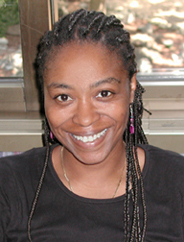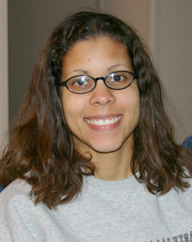
Raycine Hodo
I am originally from Rochester, New York. I went to work after graduating from high school. After performing secretarial work for 13 years, I began school part-time at Miami-Dade Community College, located in Miami, Florida, where I was living in 1996. After two semesters of part-time attendance, I tendered my resignation as Executive Secretary at Best Buddies International, a non-profit organization that specializes in working with people with mental retardation. While at Miami-Dade Community College, I participated in the Eco-Urban Program, which teaches ecology in an urban environment. As part of Eco-Urban, we spent three weeks during the summer of 1998 looking at the Everglades watershed. We traveled north to the mouth of the Kissimmee River and followed the watershed down to the beginning of the Florida Keys. We traveled east to west, as well as north to south learning about the watershed and the wildlife that inhabits the Everglades. After graduating from community college, I started at Smith College in September 1999, where I majored in Geology. While at Smith College, I participated in a 2000 summer internship as part of the Keck Consortium. We spent the summer at Carleton College in Northfield, Minnesota, and in the field collecting data on the Cannon River Watershed, a tributary to the Mississippi River. Also, at Smith College I worked with Dr. Robert Newton, my advisor, on a research project in the Adirondack Mountains. My undergraduate thesis involved looking at mercury and mercury methylation in a riparian wetland of an inlet stream to Sunday Lake in the Adirondack Mountains. I attended geology field camp through Indiana University in the summer of 2001 and finished my time at Smith in December 2001. I began working at the US Geological Survey in Troy, New York, in SCEP (Student Career Experience Program) in February 2002, and worked there until I moved to Madison, Wisconsin, to attend the University of Wisconsin-Madison to work on my M.S. degree in Hydrology.
PROJECT SUMMARY
Aquifer
Storage and Recovery (ASR) is a technology proposed for use in southern
Florida as a water-supply alternative to help restore altered hydroperiods
in the Everglades. ASR is used to store excess surface water and shallow
groundwater during wet periods for recovery during longer-term dry periods
. The proposed storage zone for ASR in south Florida is the Upper Floridan
Aquifer. Though there have been many studies conducted in the Everglades
ecosystem investigating mercury cycling, no studies have considered
methylmercury formation in deep subsurface environments.
The objectives of this study are to assess ASR technology and its potential impacts to mercury cycling in south Florida; develop a conceptual model for mercury geochemistry for Upper Floridan Aquifer; and relate ASR to the methylmercury problem in south Florida; evaluate the potential for ASR injection to methylate mercury; the time required for stored water to methylate, and the conditions under which methylation may occur in ASR stored water. The scope of this study extends to Green Bay, WI to compare analytical results of ASR in the Upper Floridan Aquifer system to water recovered from the Green Bay, WI ASR pilot project to assess the transferability of results to different aquifer systems. This study also includes speciation modeling using the MINEQL+ program to evaluate any potential chemical speciation using known parameters and for comparison to analytical results. This project is being funded by the Army Corps of Engineers and the U.S. Geological Survey. My research advisor is Dr. David Krabbenhoft, USGS, Middleton, Wisconsin.

Kuwanna Dyer
I am the 2004-2005 recipient of the BP Research Assistantship. I was born in Frankfurt, Germany, to a German-Polish mother and Afro-American father. My father was in the military at the time, and he spent a total of 29 years in the service. Thus, my younger years were spent in several places, among them Fort Knox, Kentucky; Bad Nauheim, Germany; Butzbach, Germany; and Fort Ord, California. When he retired, we moved to “fabulous” Las Vegas, Nevada, known not only for its hot summers and night life, but also for its fantastic geology, as I soon discovered in my effort to avoid the night life. Indeed, the University of Nevada Las Vegas is where I received my B.S. in geology. My current research as a Master’s student at the University of Wisconsin-Madison involves the investigation of one of nine arkosic sandstone beds (D bed; Culbertson, 1963) deposited as a part of the hypersaline Wilkins Peak Member of the Eocene Green River Formation, Wyoming. The D bed contains fluvial sandstones interbedded with siltstones and mudstones, some silt and mud and even sand showing evidence of pedogenic alteration, the degree of development varying depending on factors such as time and location. The ubiquitous occurrence of climbing ripples and channel scours, together with the local presence of insect burrows and the interwoven paleosols, suggest that the D bed was deposited by rivers and sheetfloods when lake levels were low (Eugster and Hardie, 1975; Smoot, 1983; Pietras, 2003). The presence of paleosols and insect burrows suggest that there were periods of subaerial exposure and stability, allowing pedogenesis to occur. I am using a combination of fluvial architecture description, paleocurrent measurement, and sandstone petrography to help constrain whether the arkose beds are the deposits of ancient dryland rivers; understand the relationship between sandstone deposition and lake level; i.e., whether the lake was at its driest, in the process of drying out, or beginning to refill; and determine provenance. In addition, I have detailed descriptions of all bedding showing any evidence of pedogenic alteration, my goal being to incorporate the paleosol story into the overall D bed depositional history.
top of page
Geology
& Geophysics Graduate Funding | Geology
& Geophysics Resources for Prospective Students
Geology & Geophysics UW-Madison | UW
Graduate School Diversity Resources